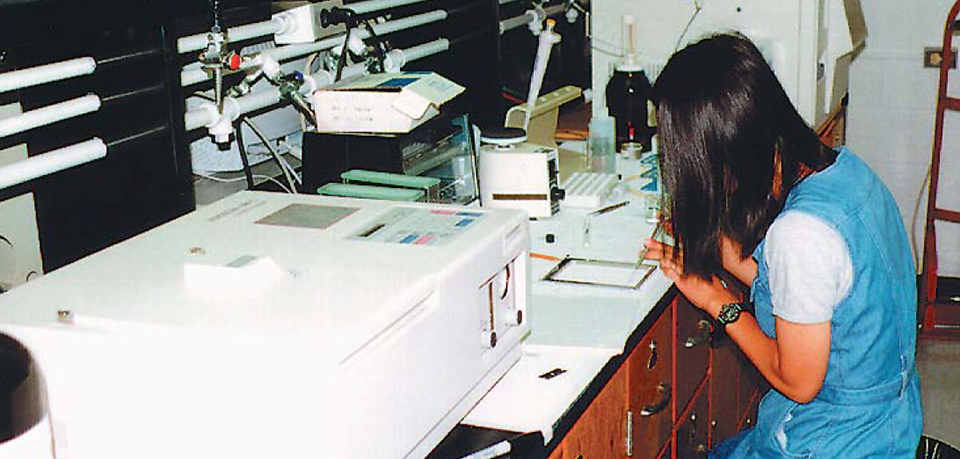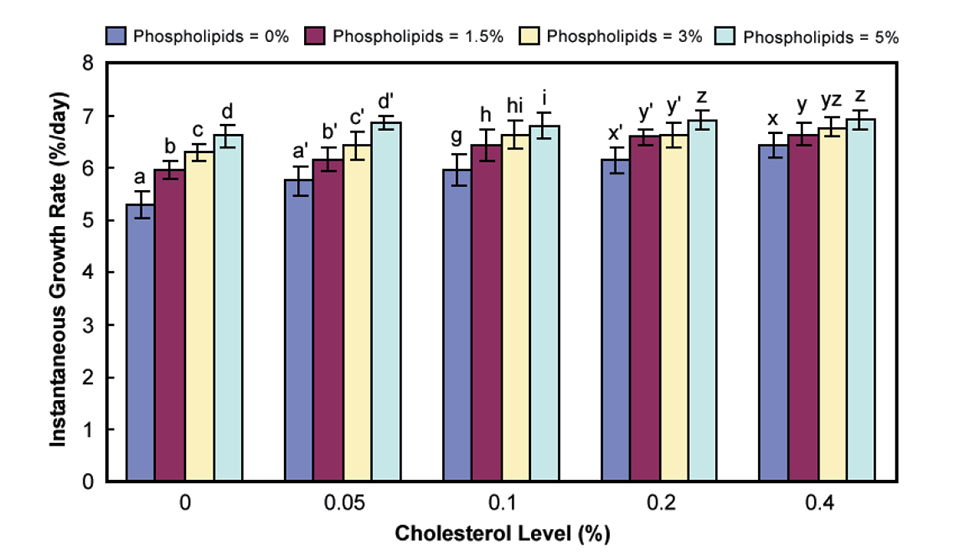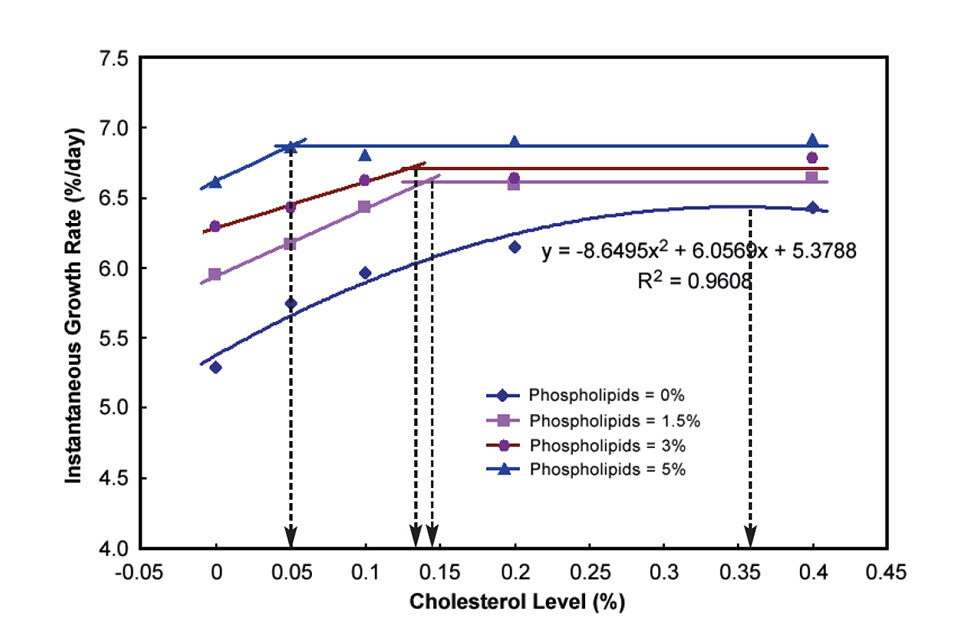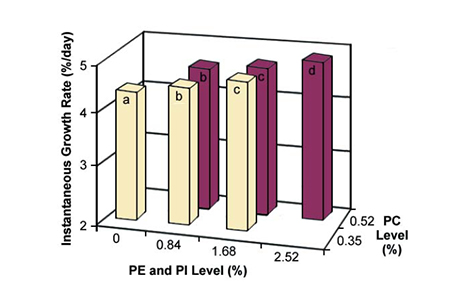Dietary supplementations of phospholipids and cholesterol are necessary for juveniles

Phospholipids and cholesterol are two essential lipids for penaeid shrimp. Yet despite the importance of Pacific whiteleg shrimp (Litopenaeus vannamei) to the shrimp-farming industry, information regarding its dietary requirements for phospholipids and cholesterol during the juvenile stage is still limited.
The authors conducted a series of tests to determine these requirements and their interaction for L. vannamei in the 0.4- to 0.9-gram size range. Studies also evaluated the active components of soybean lecithin. Tests were carried out in indoor, semi-closed recirculating systems with 8 percent daily water exchange.
Phospholipids and shrimp growth
Phospholipids serve as components of cell membranes; second messengers in cell signaling; sources of choline, inositol, and fatty acids; and mediators of lipid metabolism. Shrimp can synthesize phospholipids, but this biosynthesis generally cannot meet their metabolic requirements during juvenile and younger stages. The necessity for dietary phospholipids, such as soybean lecithin and purified phosphatidylcholine, for optimum shrimp growth and/or feed conversion has been reported in the 1 to 6.5 percent range for various species at different stages.
In our studies, deoiled soybean lecithin (97.6 percent acetone insolubles) was used as a source of phospholipids. The major components of the lecithin were 25.7 percent phosphatidylcholine (PC), 21.7 percent phosphatidylethanolamine (PE), and 8.8 percent phosphatidylinositol (PI). Results showed that dietary phospholipids increased shrimp growth rate significantly, with the growth-enhancing effect influenced by dietary cholesterol.
The calculated level of cholesterol in the basal diet was 0.06 percent. As cholesterol level increased, the phospholipid effect tended to diminish (Fig. 1). Dietary phospholipid requirement for juvenile L. vannamei was estimated to be 3 percent at 0.4 percent cholesterol, and up to 5 percent at lower supplemental cholesterol levels.

Cholesterol
Cholesterol functions as a component of cell membranes, and is important in maintaining membrane fluidity. It is also a major sterol in shrimp, a precursor of steroid hormones, and a component of lipoproteins. Shrimp cannot synthesize cholesterol from acetate and mevalonate, but may possess the ability to dealkylate some C28 and C29 sterols to cholesterol. Optimal dietary levels of cholesterol for shrimp have been reported as 0.2 to 2 percent, depending on species, stage, and other dietary ingredients.
Our studies indicated that without dietary phospholipid supplementation, 0.35 percent dietary cholesterol was required by L. vannamei for maximum growth. Dietary phospholipid had significant effects on cholesterol requirements of shrimp. As the supplemental phospholipid level increased, the dietary cholesterol requirement of shrimp tended to decrease.
An apparent plateau in instantaneous growth rate was reached in response to increasing levels of dietary cholesterol when phospholipid was 1.5 percent of diet or higher (Fig. 2). Broken-line regression analyses showed that, at dietary phospholipid levels of 1.5, 3 and 5 percent, the cholesterol requirements of L. vannamei were 0.14, 0.13 and 0.05 percent, respectively.

Interaction between phospholipids and cholesterol
Phospholipids enhance lipid transport and facilitate lipid digestion and absorption in crustaceans. Phospholipids also act as acyl donors for the lecithin-cholesterol acyltransferase, to convert cholesterol to cholesterol ester, implying an interaction between phospholipids and cholesterol.
Results from our six-week growth trial showed a highly significant interaction between dietary phospholipids and cholesterol on growth of juvenile L. vannamei. Further biochemical analyses revealed the interactive effects of these compounds on total lipid and triglyceride concentrations in the hepatopancreas, as well as on cholesterol concentration in muscle. A reduction of expensive cholesterol in shrimp diets can be achieved by supplementing soybean lecithin without affecting the shrimp performance.
Active components of soybean lecithin

Four major classes of phospholipids are commonly recognized: PC, PE, PI, and phosphatidylserine. Among them, PC is the most abundant phospholipid in animal tissues, and has been assumed to be the major active component in lecithin. Knowledge of phospholipid function and metabolism is mostly based on research of mammals, with relatively few studies done in crustaceans.
Soybean lecithins are widely used for dietary supplementation of phospholipids in shrimp studies because of their industrial availability and beneficial effects on shrimp performance. Identification of active components of soybean lecithin is very important for a better understanding of the role of phospholipids in shrimp nutrition and lipid metabolism.
When diets were supplemented with purified PC (93 percent PC and 3 percent lysophosphatidylcholine) at 0 to 4.2 percent in our studies, no effect was observed on growth and survival of L. vannamei juveniles. However, at a certain PC level, PE and PI showed significant growth-enhancing effects (Fig. 3).
Dietary phospholipids and purified PC showed different effects, not only on shrimp growth, but also on lipid content and fraction in shrimp tissues. Diets supplemented with phospholipids resulted in higher total lipid in hepatopancreas and lower total lipid in muscle of shrimp than diets without supplemental phospholipids. In contrast, increasing purified PC in the diets decreased total lipid, free fatty acid level and other phospholipids in hepatopancreas, but did not influence total lipid level in shrimp muscle.
Conclusion
Our studies concluded that dietary supplementations of phospholipids and cholesterol are necessary for juvenile L. vannamei. There were interactive effects between phospholipids and cholesterol on shrimp performance.
Cholesterol requirement can be lowered as dietary phospholipid level increases. A combination of 0.05 percent cholesterol and 5 percent phospholipid is recommended for intensive L. vannamei culture.
This research raises the possibility of modifying the diet to produce low-cholesterol shrimp, but more studies are needed in this area.
Purified PC alone was nutritionally inferior to soybean lecithin in improving shrimp growth. Dietary PI and PE enhanced shrimp growth. Further studies are needed to investigate PL effects on requirements of fatty acids and lipid-soluble vitamins for shrimp.
(Editor’s Note: This article was originally published in the April 2001 print edition of the Global Aquaculture Advocate.)
Now that you've finished reading the article ...
… we hope you’ll consider supporting our mission to document the evolution of the global aquaculture industry and share our vast network of contributors’ expansive knowledge every week.
By becoming a Global Seafood Alliance member, you’re ensuring that all of the pre-competitive work we do through member benefits, resources and events can continue. Individual membership costs just $50 a year. GSA individual and corporate members receive complimentary access to a series of GOAL virtual events beginning in April. Join now.
Not a GSA member? Join us.
Authors
-
Hui Gong, Ph.D.
Arizona Mariculture Associates, LLC
Dateland, Arizona, USA -
D.H. Jiang, Ph.D.
Arizona Mariculture Associates, LLC
Dateland, Arizona, USA[109,111,99,46,111,110,117,106,64,103,110,97,105,106,104,100]
-
Addison L. Lawrence, Ph.D.
Texas A&M University System
Shrimp Mariculture Project
Port Aransas, Texas, USA -
Delbert M. Gatlin III, Ph.D.
Department of Wildlife and Fisheries Science
Texas A&M University
College Station, Texas, USA
Related Posts

Aquafeeds
Alternative lipids spare fish oil in rainbow trout feeds
Alternative lipids have achieved varied success in ensuring adequate growth and fatty acid composition in fillets. The authors evaluated rainbow trout raised on diets containing fish oil or a blend of fish and standard or modified lipids varying in fatty acid composition.

Responsibility
Biofloc technology options for aquaculture
Biofloc technology offers advantages for the sustainable culture of shrimp and some species of fish.

Aquafeeds
Green water meal has potential as aquafeed ingredient
Green water, which describes the typical water color in tropical aquaculture facilities, consists mainly of various phytoplankton species along with bacteria, protozoa and zooplankton. It is relatively easy to produce without any supplemented nutrients.

Aquafeeds
Microminerals are important feed components
Microminerals participate in a variety of biochemical processes and must be supplied in prepared diets to support optimal growth and production efficiency.


